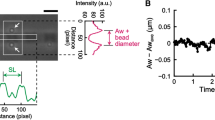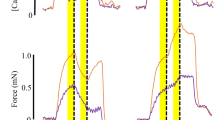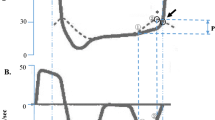Abstract
TWITCHES in skeletal muscle are preceded and accompanied by changes in optical properties of the muscle fibres1–11. Measurements of birefringence give large signals which can be separated into two main components6–8: the first begins on the falling phase of the action potential, and reaches a peak at the onset of tension development; this is followed by a late signal which is thought to be associated with development of tension by the contractile proteins2,3,6. Since the early signal precedes tension development, it could provide an important tool for studying intervening steps in excitation–contraction coupling. This signal has recently been attributed to potential changes in the sarcoplasmic reticulum (SR) membrane, associated with Ca2+ release into the sarcoplasm6,10. We have simultaneously recorded birefringence signals and changes in intracellular Ca2+ concentration, using arsenazo III, in frog muscle fibres. The results show that the onset of the early birefringence signal coincides with the rise in sarcoplasmic Ca2+ concentration, and that both can be abolished by injecting EGTA to chelate the sarcoplasmic Ca2+. This suggests that the early birefringence signal arises from some process dependent on the rise in sarcoplasmic Ca2+, and is not caused by events in the SR associated with the calcium release mechanism.
This is a preview of subscription content, access via your institution
Access options
Subscribe to this journal
Receive 51 print issues and online access
$199.00 per year
only $3.90 per issue
Buy this article
- Purchase on Springer Link
- Instant access to full article PDF
Prices may be subject to local taxes which are calculated during checkout
Similar content being viewed by others
References
Hill, D. K. J. Physiol., Lond. 108, 292–302 (1949).
Eberstein, A. & Rosenfalck, A. Acta physiol. scand. 57, 144–166 (1963).
Barry, W. H. & Carnay, L. D. Am. J. Physiol. 217, 1425–1430 (1969).
Carnay, L. D. & Barry, W. H. Science 165, 608–609 (1969).
Bezanilla, F. & Horowicz, P. J. Physiol., Lond. 246, 709–735 (1975).
Baylor, S. M. & Oetliker, H. Nature 253, 97–101 (1975).
Oetliker, H., Baylor, S. M. & Chandler, W. K. Nature 257, 693–696 (1975).
Baylor, S. M. & Oetliker, H. J. Physiol., Lond. 264, 141–162 (1977).
Baylor, S. M. & Oetliker, H. J. Physiol., Lond. 264, 163–198 (1977).
Baylor, S. M. & Oetliker, H. J. Physiol., Lond. 264, 199–213 (1977).
Kovács, L. & Schneider, M. F. Nature 265, 556–560 (1977).
Miledi, R., Parker, I. & Schalow, G. Proc. R. Soc. Lond. B 198, 201–210 (1977).
Miledi, R., Parker, I. & Schalow, G. J. Physiol., Lond. 269, 11–13P (1977).
Ashley, C. C. Am. Zool. 7, 647–659 (1967).
Author information
Authors and Affiliations
Additional information
The erratum article can be found online at https://doi.org/10.1038/271585b0
Rights and permissions
About this article
Cite this article
SUAREZ-KURTZ, G., PARKER, I. Birefringence signals and calcium transients in skeletal muscle. Nature 270, 746–748 (1977). https://doi.org/10.1038/270746a0
Received:
Accepted:
Published:
Issue Date:
DOI: https://doi.org/10.1038/270746a0
This article is cited by
-
Calcium transients in skeletal muscle fibres under isometric conditions and during and after a quick stretch
Journal of Muscle Research and Cell Motility (1991)
-
Effect of caffeine on the birefringence signal in single skeletal muscle fibers and mammalian heart
Pfl�gers Archiv European Journal of Physiology (1983)
-
An appraisal of the evidence for a sarcoplasmic reticulum membrane potential and its relation to calcium release in skeletal muscle
Journal of Muscle Research and Cell Motility (1982)
-
Transition temperature of excitation–contraction coupling in frog twitch muscle fibres
Nature (1979)
-
Birefringence signals and tension development in single frog muscle fibres at short stimulus intervals
Experientia (1979)
Comments
By submitting a comment you agree to abide by our Terms and Community Guidelines. If you find something abusive or that does not comply with our terms or guidelines please flag it as inappropriate.



